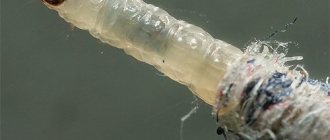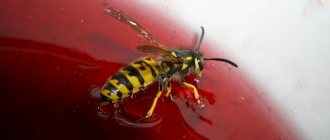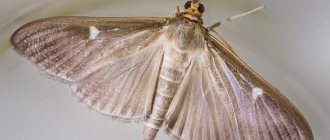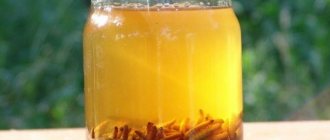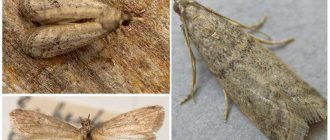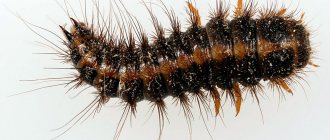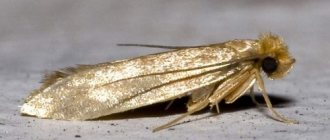What moth larvae look like
Moth larvae are caterpillars with a white, sometimes yellowish translucent body and a black head. The parasite has powerful jaws that allow it to cut fur or chew hard foods.
The larvae have small legs with which they move. The caterpillar's body is thin and oblong. Externally, an insect at this stage of development looks like a worm. The body length of the pest is 3-7 mm.
There are 6 main types of house moths:
- grain;
- fur coat;
- kitchen;
- wardrobe;
- furniture;
- carpet
The larvae of any of the above types of pests look almost identical. But environmental conditions often determine what color a caterpillar's body will be.
Food moth
Experts know what a food moth larva looks like. The caterpillar's body is transparent beige or light brown. Body length – up to 20 mm.
The worm's head stands out. It has a dark brown color. The larva also has tenacious paws for rapid movement.
Clothes moth
Knowing what clothes moth larvae look like, it will be easy to distinguish them from another species. The caterpillar's body length is up to 1 cm. The body of the worm is translucent with a beige or yellowish tint.
The insect's head is darker.
It has 2 large mandibles with teeth, with which the parasite can cut through products made of natural wool and other fabrics.
Folk remedies for moths
We have already talked about the detrimental effects of direct sunlight and fresh air on caterpillars. In addition, they die from high temperatures. After about half an hour of constant exposure to temperatures of about 50°C, the caterpillars die. To do this, woolen products just need to be ironed.
You should be more attentive to the contents and cleanliness of drawers, cabinets, suitcases - any places where clothes are intended to be stored. Doors must be tightly closed.
Fir oil. There are persistent rumors about the effectiveness of this repellent. In addition to cotton swabs soaked in fir oil, you can also place small sprigs of dried lavender wrapped in gauze in the closet.
Also, moths cannot tolerate the smell of pepper, geranium, or nettle leaves. You just need to replace the leaves placed in the cupboard with freshly picked ones a few times a week, and the effect is guaranteed.
How to get rid of moths and their larvae
There are many ways to get rid of moth larvae. If a caterpillar is discovered, you need to go through all the things and food in the closet.
Contaminated food should be thrown away or kept in the oven for 30 minutes (50 degrees). Things should be washed at a temperature of 60 degrees or aired in the sun or frost.
It is recommended to wipe kitchen cabinets with vinegar or soapy water. Carpets and furniture must be treated with insecticides and then vacuumed.
Application of chemicals
One of the most effective ways to destroy moth larvae in the house is to use chemicals. The insecticide contains substances that negatively affect the nervous and muscular systems of the parasite, which leads to its subsequent death.
If there are moths in the apartment, aerosols are most often used:
- Tornado;
- Clean house;
- Extra Meat;
- Armol;
- Difox;
- Raptor
- Argus
- Dichlorvos Neo.
It is advisable to carry out the treatment in a protective suit, goggles, mask, and gloves. The disadvantage of aerosols is that after spraying them, sometimes an unpleasant odor remains.
To destroy caterpillars, it is enough to treat infected things and surfaces with an aerosol 1-2 times. The insecticidal effect of the drug lasts about 6 months.
Folk methods of struggle
To get rid of larvae, folk remedies are often used.
So that pests do not appear on clothes or food, it is worth trying to eliminate them with essential oils.
What parasites dislike the most is the smell of the following oils:
- geranium,
- lavender,
- grapefruit,
- mint,
- lemon,
- eucalyptus,
- orange.
Add 5 drops of extract to 1 liter of water. The resulting solution is used to treat hard-to-reach places in the sofa, other upholstered furniture, cabinets, carpets, clothes, and baseboards.
Lepidoptera caterpillars die in the open sun. Therefore, if possible, clothes, carpets and other contaminated items should be taken outside or onto the balcony for 1-4 hours. Afterwards everything needs to be washed, washed and dried.
Frost also helps remove pests. To destroy the caterpillars, things are taken out into the cold for several hours.
People who have successfully gotten rid of pests using folk remedies know how else to remove moth larvae.
Popular methods of removing parasites:
- sagebrush. A decoction is prepared based on the leaves and seeds of the herb. The resulting solution is used to treat contaminated products.
- Soap and pine needles. Domestic butterflies are destroyed by alkali and repelled by the smell of pine needles. Soap is dissolved in boiling water and pine needles are placed there. After 20 minutes, the items are soaked in the solution for 10 minutes.
- Boiling water. Contaminated clothing should be immersed in boiling water for 10-20 minutes.
- Tobacco. The acids contained in the plant have a detrimental effect on the larvae. Tobacco leaves are infused in hot water. A spray bottle is filled with liquid, and then sprayed over all places where parasites live.
At what temperature do moths and their larvae die?
Many housewives who have lepidopteran insects want to know at what temperature the moth larvae die. Experts say that for reproduction and normal existence, parasites need a temperature of 20-30 degrees.
If the indicator is less than 15°C, the pests’ metabolism will slow down significantly and they will become inactive. If the temperature returns to normal, the pests will continue their activity.
Insects are killed by temperatures less than 10 °C and more than 30 °C.
Video
How to get rid of moths?
Application of wax moth larvae
Such a household pest can be useful to humans, so do not rush to get rid of it by collecting it using special or folk remedies. Wax moth larvae extract has a strong antibacterial and antiviral effect and is widely used in the treatment of viral colds, and numerous positive reviews prove the effectiveness of this remedy.
A tincture based on wax moth larvae is taken orally 35-40 minutes before meals; it must first be diluted in 50-120 g of water or tea. For prevention, the drug is used 1-2 times a day and 2-3 times during treatment for 3 months.
Nutrition of larvae
The caterpillar feeds on a variety of foods or things. In nature, pests eat fruits, feathers, berries, wool, grains, vegetables or nuts.
Housewives in whose homes these parasites lived know what house moth larvae eat. Once in the house, insects begin to actively feed on hair, fur, and fabrics (linen, silk, cotton, wool).
Parasites also love to eat products made from natural fur. Moreover, insects choose old materials, which are better to chew and digest.
Clothes moth larvae are quite fastidious in their diet. They love to eat sweaty clothes or stained carpets.
Kitchen moth larvae consume bran, sweets, flour, cereals and nuts. Insects also eat cookies, pasta, tea, and dried fruits.
The larva's stomach is very small, so the parasite leaves behind an insignificant trace. Because of this, the presence of moths for a long time is often unnoticed. Parasites are discovered after their active reproduction, when the number of caterpillars becomes enormous.
So, moth larvae feed differently.
And the type of food determines the name of the insect:
| Type of insect | What does it eat? |
| Carpet | Paths, rugs, carpets |
| Fur coat | Fur coats, animal hair or products made from it |
| Cereal | Corn |
| Clothes | Felt products, fruits |
| Furniture | Furniture upholstery |
| Kitchen | Nuts, grains, seeds, dry fruits, legumes |
How to prevent moths from entering and destroying your home?
To prevent moths from breeding in the kitchen, try to take the following measures from time to time:
- Periodically inspect kitchen cabinets, drawers or compartments where food is stored;
- Throw away spoiled or contaminated food and wash storage containers;
- Wipe kitchen cabinets, drawers and other places where you store food with a vinegar solution. To do this, dilute 30-40 ml of 5% vinegar per 5 liters. water;
- Also, during wet cleaning, you can add a few drops of essential oil (lavender, orange, rosemary) to the water;
- Install a very fine mosquito net on the ventilation to prevent entry through this route;
- Place fragrant herbs in fabric bags in storage areas;
- Ventilate the kitchen regularly.
REFERENCE: Food moths do not like the smell of geranium. This flower on the kitchen windowsill will reduce the chances of the pest spreading.
To prevent clothes moths from multiplying, you should adhere to the following tips:
- In the summer, take items made from natural fur or wool out into the sun;
- Shake clothes that are vulnerable to moths; the larvae do not adhere well to the fabric;
- Periodically wipe the shelves in your closet with water and essential oil;
- Use special anti-moth aerosols to treat furniture, wool and fur items;
- Install special traps or repellents in the closet. The same applies to furniture with natural upholstery;
- To repel moths, use a fumigator;
- If you are concerned about outerwear made of natural fur, leave fabric bags with tobacco in your pockets for a warm period of time.
Peculiarities of moth reproduction
Moths have 4 stages of development. The timing of the stages varies and depends on the type of insect and its living conditions.
The development cycle of the lepidopteran parasite consists of a number of stages:
- egg laying;
- hatching of larvae;
- transformation of a caterpillar into a pupa;
- adult.
At a time, the female lays 40-200 eggs, up to 1 mm in size. Further development of eggs is regulated by temperature. On average, the process lasts up to 3 weeks.
Experts know how moth larvae appear. The caterpillar hatches from the egg. The worm has a transparent skin, and its body length reaches 1 mm.
The caterpillar goes through several stages of molting and then becomes a pupa.
It is noteworthy that food species develop in 4-5 months, and clothing species - up to 90 days.
For pupation, insects choose hard-to-reach, dark places. But some types of lepidoptera prefer bright places.
Many species of house moths make a cocoon for themselves. This is a cover woven from a substance resembling silk. In a protective cocoon, the larva is in the pronymph state, and then it molts.
The integument of the pupa hardens over time. The shell protects the insect until it transforms into a butterfly (up to 14 days).
The lifespan of an adult is up to 3 weeks. During this time, she mates, looks for food for the larvae, and leaves offspring.
Cleanliness and tidy
The most popular items from our wardrobe, which we wear from time to time in winter, are not affected by moths. And how many deposits of sometimes unnecessary warm clothes are stored in our closets and pantries? This clothing is the most vulnerable to the effects of moths, and it is the most difficult to remove from there. After all, old clothes are kept in a closed space in a dark closet for a long time, without being ventilated at all.
Therefore, the easiest way to prevent the appearance of moth caterpillars in the closet is to frequently clean the apartment, clean carpets and furniture, and systematically clean clothes. It is most effective to carry out such procedures in the spring, since moths usually lay eggs in March.
Before storing winter items, it is recommended to clean and then dry warm items. It is best to combine these procedures with an hour-long sunbath. Moth eggs are killed by ultraviolet rays.
Clothing that has gone through all stages of processing should be stored in tightly closed bags or bags, periodically inspecting them for the presence of moths.
Prevention
To prevent the moth larva from actively destroying valuables or food, it is important to know how to prevent the pest from appearing in the house. To protect your home, it is important to follow a number of rules.
So, only washed items should be stored in closets. From time to time, all woolen or fur products and natural fabrics must be ventilated in frost or sun.
Other rules of prevention:
- Fur and wool must be periodically treated with insecticides.
- Items cannot be placed in plastic bags.
- Herbs that repel parasites (tansy, wormwood, lavender) should be placed in the wardrobe and chest of drawers.
- You can place citrus peels in the kitchen.
- On shelves with clothes you need to place pieces of foam rubber soaked in essential extracts.
- All food products that can be damaged by larvae must be periodically sorted and stored in closed containers.
- Regularly you need to carefully inspect all seams and folds on things for the presence of parasites.
Microscopic larvae can ruin expensive and valuable things. Therefore, it is easier to prevent their occurrence than to purchase a new fur coat, furniture or carpet.
To do this, it is important to follow the prevention rules described above. And at the first sign of moths appearing in the house, carry out a thorough disinfection.
So, what is the moth afraid of?
A lot of things actually. These include various odors, and certain, and far from the most critical in our understanding, temperature indicators; finally, it can be exterminated using folk remedies or modern chemical insecticides.
But let's start in order. There is a reasonable opinion that it is simpler and cheaper to organize preventive measures and create a kind of barrier system for moths than subsequent costly control of extermination.
Smells
The basis of any method of repelling moths is an indisputable fact - moths are afraid of smell!
The source of the aroma that repels these insects can be anything:
- Plants and herbs.
- Some types of fruits.
- Essential oils.
- Synthesized drugs.
The smell of which plant is moth afraid of?
The most effective herbal remedy that stops the appearance of moths is lavender. The aroma of the flowers of this plant, pleasant to the human sense of smell, but not tolerated by moths, will be an excellent preventive remedy in a chest of drawers or wardrobe.
They also do a good job of repelling moths:
- Tansy inflorescences, however, as with many other types of insects.
- Wormwood is a specific, rather strong, but not for everyone's scent.
- Rosemary is good for everyone, but it loses its flavor extremely quickly.
- Dill, well, it’s clear here - kitchen, not for long, cheap.
When choosing a specific plant for organizing preventive measures in your home wardrobe, you should focus not only on personal preferences in fragrances
It is important to remember that the period in which the smell of each plant “works” is limited
Dried herbs retain their properties for several months. Lavender is the recognized leader here too. In addition, an extremely rare, in comparison with other herbal remedies, addiction to its smell of populations of a particular area was noted.
Fruits
Here we are talking, as a rule, about citrus fruits. Lemon, tangerine, orange are fruits that have a very pungent odor that perfectly resists moths. Most often, for prevention, the zest or peel of these fruits is used.
Essential oils
Another very interesting and pleasant to the smell answer to the question of what smells moths are afraid of is essential oils.
In principle, the base on which this or that extract is created are the same plants and fruits:
- Lavender.
- Eucalyptus.
- Patchouli.
- Lemon.
- Coniferous leaves.
The highlight of this method is that the extract from many other flora specimens, through some chemical additives and improvements, receives a serious bonus - odor persistence and high concentration of the substance. This increases the duration of action of this product and expands the scope of its application.
Synthetic scents
A wonderful modern method used by many is sections
or sachet,
special devices that emit a strong, moth-repellent odor. The working preparations in them are chemically composed analogues of natural substances, and, quite often, with a certain proportion of insecticides. So to speak, a two-in-one method - it frightens and kills!
How to deal with wax moths in honeycomb storage
Cell storage is a room for storing spare cells. Every responsible beekeeper should have them. Sometimes they are kept in a cellar, basement or unheated garage. To prevent the appearance of parasites, carry out regular disinfection and prevention against wax moths.
In honeycomb storage facilities, wax moths appear at high temperatures and humidity, as well as poor ventilation.
Stopmol is a common medicine to combat wax moths in honeycomb storage. The preparation consists of small cardboard plates soaked in fir and coriander oil. The medicine has an insecticidal effect and affects moths at different stages of development.
Instructions for fighting wax moths using Stopmol for bees:
- Affected honeycombs are removed from the hive.
- Open the package and make 4 holes in the corners of 1 cm in size on each plate.
- The drug is laid out on honeycomb frames and packed in polyethylene or stored in sealed honeycomb storage containers.
- To completely get rid of insects, you need to use 1 plate for 12 frames.
- The course of treatment is 1.5 months, after which the plate is removed and the frames are ventilated.
